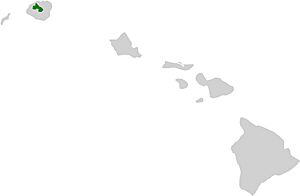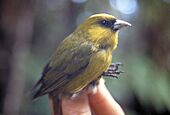ʻAkekeʻe facts for kids
Quick facts for kids ʻAkekeʻe |
|
|---|---|
 |
|
| Male above, female below | |
| Conservation status | |
| Scientific classification | |
| Genus: |
Loxops
|
| Species: |
caeruleirostris
|
 |
|
The ʻakekeʻe (say "ah-keh-KEH-eh"), also called the Kaua'i 'akepa, is a special type of bird. It belongs to the Fringillidae family, which includes finches. This bird is part of the Hawaiian honeycreeper group.
You can only find the ʻakekeʻe on the island of Kauaʻi in Hawaii. It lives in small numbers in the higher parts of the island. For a while, the ʻakekeʻe and the ʻakepa were thought to be the same species. This was because they are similar in size and have unusual bills. However, scientists later found they were different because of their colors, how they build nests, and their calls. The ʻakekeʻe is now in great danger. It might disappear very soon if we don't control mosquitoes on Kauaʻi.
What Does the ʻAkekeʻe Look Like?
The ʻakekeʻe is a greenish-yellow bird. It has a black mask around its eyes, which is easy to see on the male birds. Its bill is bluish. This is different from the ʻakepa, which is usually red, yellow, or orange. The ʻakepa also does not have a black mask and has a horn-colored bill.
The tips of the ʻakekeʻe's bill cross over each other. It uses its bill like scissors to open up plant buds. It searches inside these buds for insects to eat. This bird also sips nectar from some trees. The ʻakekeʻe builds its nests mostly from twigs. It places them high up in trees. The ʻakepa, on the other hand, uses holes in trees for its nests.
Where Does the ʻAkekeʻe Live?
Today, you can only find the ʻakekeʻe in a few places on Kauaʻi. These areas include Waimea Canyon State Park, Alakaʻi Wilderness Preserve, and Kōkeʻe State Park. This bird is moving closer to extinction because it cannot handle changes to its home.
Its natural home is in mesic (medium wet) and wet forests. It especially needs ʻōhiʻa lehua (Metrosideros polymorpha) trees to survive.
Why Is the ʻAkekeʻe in Danger?
The ʻakekeʻe faces many dangers. One problem is the arrival of new plants like the banana pōka (Passiflora tarminiana). This passionflower vine grows over and replaces the native plants. Wild feral pigs and feral goats also harm the native plants. When native plants disappear, the insects the ʻakekeʻe eats also decline.
Mosquitoes that were accidentally brought to Hawaii also cause problems. They spread diseases like Avian malaria (Plasmodium relictum) and fowlpox. These diseases affect the ʻakekeʻe. Because of this, the birds can only live in areas above 1,100 meters ASL. Mosquitoes do not usually live at such high elevations. Also, cutting down forests on Kauaʻi has caused a loss of habitat for this and many other bird species.
The ʻakekeʻe's conservation status changed to critically endangered in 2008. This was because its numbers dropped very quickly. In 2012, there were fewer than 5,000 birds. By 2016, there were fewer than 1,000. In 2021, the number was less than 638. The ʻakekeʻe is declining faster than any other threatened Hawaiian bird. Its population shrinks by 21% every year. At this rate, scientists predict it could be extinct by 2028.
Only 7 ʻakekeʻe birds are known to be in captivity. However, these birds do not do well in captivity because they need to interact with other birds. The best way to help them is to control mosquitoes across large areas. This can be done using a special method with Wolbachia bacteria.



